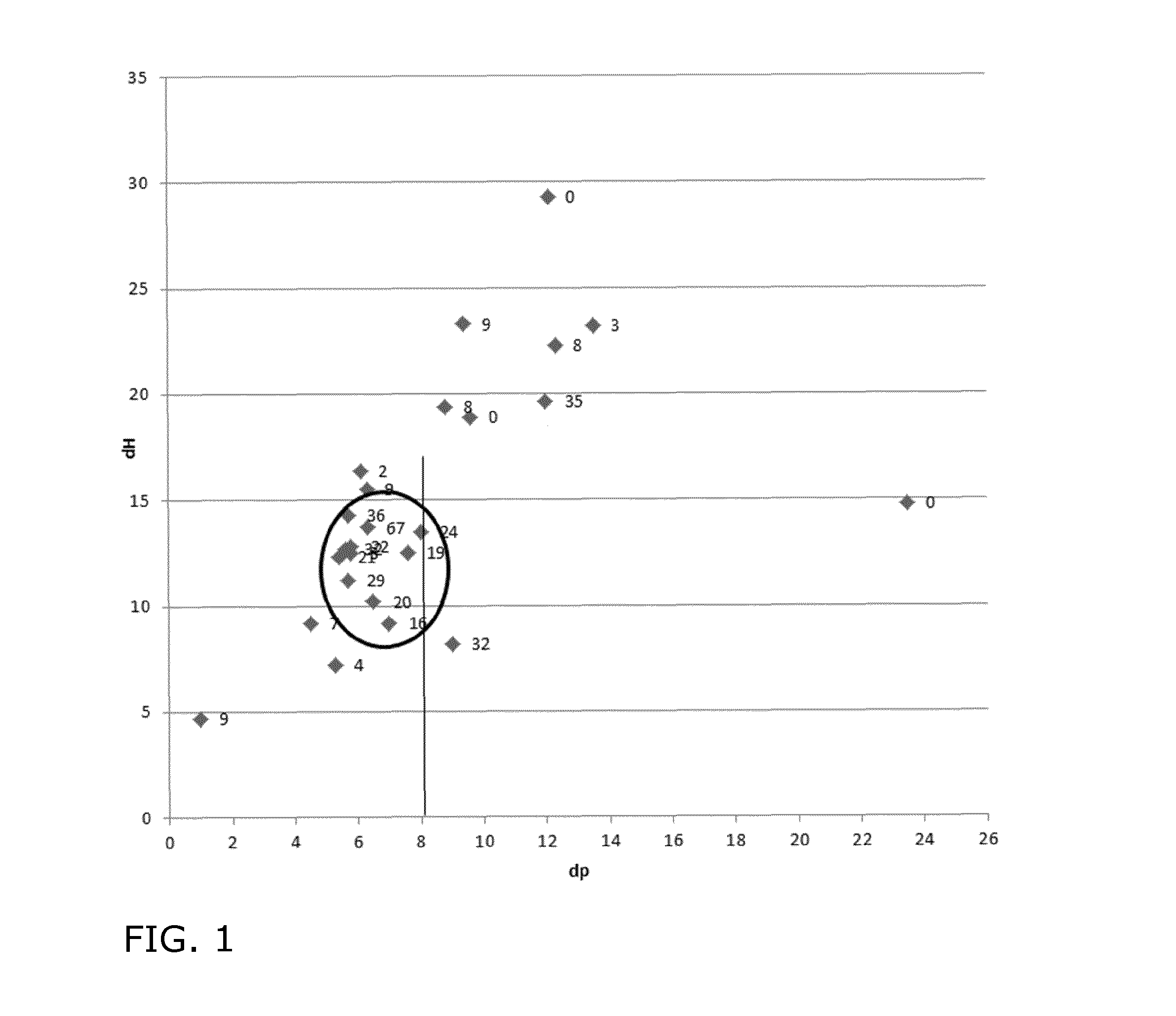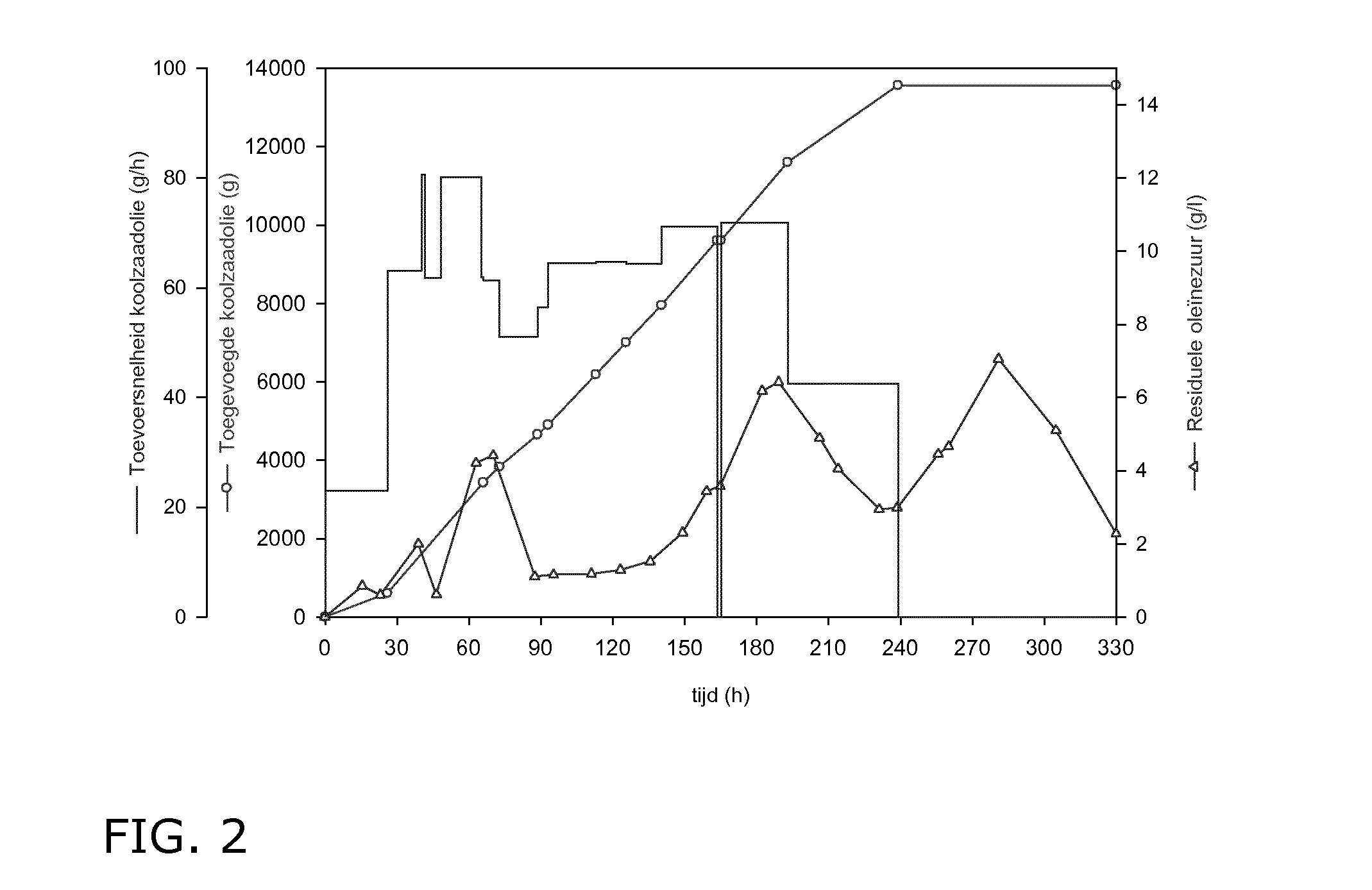Sophorolactone production
a technology of sophorolactone and production process, which is applied in the direction of non-ionic surface active compounds, organic chemistry, detergent compounding agents, etc., can solve the problems of affecting product development, difficult production of a product having a given ratio using a fermentation process, and formation of numerous homologs, so as to reduce the formation of acid sophorolipids, the effect of facilitating downstream processing and facilitating foam control
- Summary
- Abstract
- Description
- Claims
- Application Information
AI Technical Summary
Benefits of technology
Problems solved by technology
Method used
Image
Examples
example 1
[0152]A preculture of Candida bombicola ATCC 22144 was grown for 72 hours at 25° C. in 4 Erlenmeyers of 1 liter medium each with the composition as listed in Table 3.
TABLE 3Corn steep liquor medium (CSL)ComponentConcentration (g / l)Glucose•H2O55 g / l Dried CSL (Roquette)5 g / l(NH4)2SO44 g / lKH2PO41 g / lMgSO4•7H2O0.5 g / l
[0153]Contrary to prior art disclosures this preculture is essentially free of oily substrate and it was used in the stationary rather than in the exponential growth phase. After 72 hours the preculture is used to inoculate a previously sterilized Biostat U50 (Sartorius BBI Sytems) containing 40 liter sterile medium with the same composition as the preculture. A double fedbatch fermentation was operated at 110-130 rotations per minute (rpm), 25° C., 0.5 bar and pH 3.5. Aeration was set at 1 vvm (amount of the introduced air versus the bioreactor's working volume), decreased to 0.1 vvm after 40 hours in order to control excessive foam formation, and raised again after 180 ...
example 4
[0161]Example 1 was repeated in a Biostat D100 containing 70 liter of CSL medium at 25° C. to which a total of 240 g / l rapeseed oil was added controlling the residual oleic acid content. The fermenter was inoculated using 1.4 liter CSL medium without oil and grown in 7 1-liter Erlenmeyers for 72 hours at 25° C. until the stationary phase was reached.
[0162]After 183 hours 254 g / l sophorolipids were present again virtually free of the acid form as evidenced under the microscope by the presence of crystals during the fermentation. The production rate and the substrate conversion were respectively 1.39 g / l.h and 0.62%.
example 5
[0163]The previous example was repeated but using a preculture in the exponential growth phase (similar to example 3), grown with 5 g / l rapeseed oil for 25 hours at 25° C.
[0164]After 160 hours 246 g / l sophorolipids were present as an oily phase, probably due to the presence of substantial amounts of the acid form as evidenced by HPLC analysis. Continuing the fermentation process until 330 hours resulted in decreased production rate of 0.9 g / l.h and a total yield of 297 g / l.
[0165]Examples 4 and 5 confirm the importance of an oil-free preculture in the stationary phase for obtaining crystalline sophorolipids rich in the lactone form.
PUM
| Property | Measurement | Unit |
|---|---|---|
| temperature | aaaaa | aaaaa |
| temperature | aaaaa | aaaaa |
| temperature | aaaaa | aaaaa |
Abstract
Description
Claims
Application Information
 Login to View More
Login to View More - R&D
- Intellectual Property
- Life Sciences
- Materials
- Tech Scout
- Unparalleled Data Quality
- Higher Quality Content
- 60% Fewer Hallucinations
Browse by: Latest US Patents, China's latest patents, Technical Efficacy Thesaurus, Application Domain, Technology Topic, Popular Technical Reports.
© 2025 PatSnap. All rights reserved.Legal|Privacy policy|Modern Slavery Act Transparency Statement|Sitemap|About US| Contact US: help@patsnap.com



